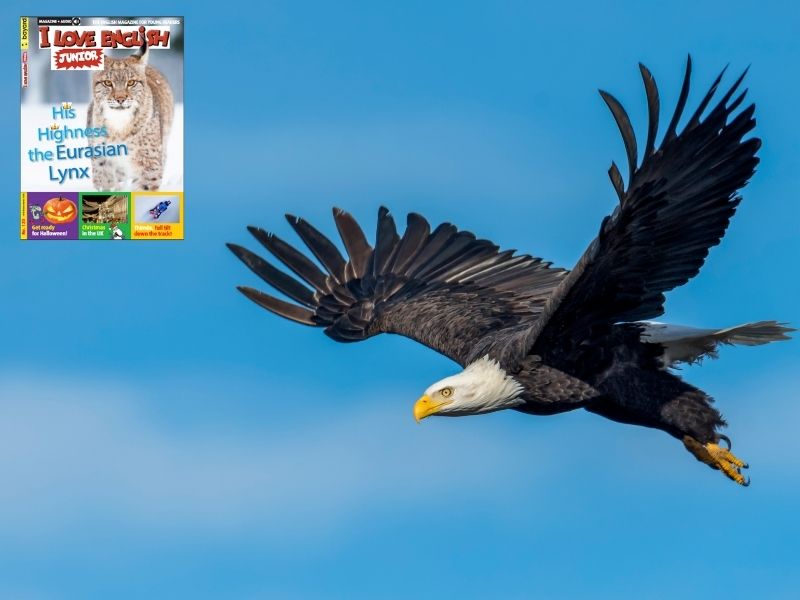Inglés para niños: 10 amazing facts about eagles
10 datos sorprendentes sobre las águilas para que los niños aprendan inglés de forma divertida
Publicado por Alba Caraballo, editora de Conmishijos.com
Creado: 1 de junio de 2023 16:06 | Modificado: 9 de abril de 2025 08:22
Te invitamos a leer 10 datos asombrosos sobre las águilas: 10 amazing facts about eagles. Una lectura muy divertida e interesante para niños de Primaria, de la mano de la revista para aprender inglés I Love English Junior (noviembre 2021, número 120).
Los niños conocerán datos sorprendentes sobre estas aves de presa. Además, aprenderán nuevo vocabulario y practicarán la lectura en inglés.
Ver +: Lecturas para niños en inglés
10 amazing facts about eagles: lecturas en inglés para niños

1. Eagles are large and powerful birds. That?s why they are a symbol of power and freedom, and for many they are "The king of Birds". They can fly at over 3,000 metres high and reach a speed of about 56-70 kph when gliding or flapping. They are also very strong and can carry heavy loads of up to 6 kg (around 15 pounds).
2. There are more than 60 eagle species, which vary in height, length and weight depending on the environment they live in. For instance, those living in forests have shorter wingspans, while eagles that live in open areas have longer wingspans. Their average wingspan is around 2 metres (6 feet).
3. Most types of eagles are carnivorous. They feed on fish (like salmon, trout, carp and eels), on birds (like ducks and herons), and on mammals (like rabbits, beavers and baby deer). To be able to pluck fish out of the water, eagles use their talons and their claws. They dive down at between 120 and 160 kph to catch prey.
4. Baby eagles are called eaglets. They grow very quickly ? about 170 grams a day! At eight weeks old, they can flap their wings and rise in the air. When eaglets are born, they are covered in gray feathers and don?t have the typical brown and white pattern until they are 4 years old, when they develop their heads and tails fully.
5. Eagles have excellent eyesight. Their large eyes can take up around 50% of the head. They can also distinguish more colours than humans! That?s because their eyes contain many more light-sensitive cells than the human eye. They can see long distances for prey ? up to 1.6 km away!
6. Eagles build their nests on high cliffs or at the top of tall trees to keep the eggs safe. Some eagles have built nests so heavy that they have broken the tree. They normally lay two eggs per year, although, in most cases, one of the baby eagles is stronger than its sibling and will kill the weaker one.
7. The bald eagle isn?t really bald. In the past, bald meant "white-headed", and this eagle species has a white head while the rest of its body is brown. Bald eagles live near lakes, rivers and coasts in the USA, Canada and northern Mexico. The bald eagle is an emblem of the United States.
8. Female eagles are 25% bigger than males. A male and female eagle tend to stay together all their lives! Eagles can mate while flying or free falling. When they lay eggs, the female keeps them warm for about 35 days, while the male brings food to the nest. Eagles defend their territory tenaciously against other eagles or predators like owls, gulls or mammals such as raccoons and bears that can hunt at night when eagles are vulnerable.
9. Although eagles can live for up to about 35 years in the wild, this is not always the case and they normally get weaker towards the end of their lives and can?t hunt as when they are younger. The average lifespan of an eagle is between 15 and 20 years depending on the species and the ecosystem where it lives.
10. For many people, eagles bring good luck. Eagles have been featured on various national flags and on the coat of arms of countries such as Germany, Mexico, Egypt, Poland and Austria. Ancient Aztecs believed that when an eagle landed on a spot, that should be the location to build their city.
Artículos relacionados
Inglés para niños: 10 amazing facts about London
Te invitamos a leer 10 datos asombrosos sobre Londres en inglés: 10 amazing facts about London. Una lectura muy divertida e interesante para niños de Primaria, de...
Inglés para niños: 10 amazing facts about butterflies
10 datos sorprendentes sobre las mariposas para que los niños aprendan inglés de forma divertida: 10 amazing facts about butterflies
Inglés para niños: 10 amazing facts about zebras
Te invitamos a leer 10 datos asombrosos sobre las cebras en inglés: 10 amazing facts about the zebras. Una lectura muy entretenida para niños de Primaria, de la...
Lecturas en inglés para niños: 10 amazing facts about skyscrapers
¿Quieres saber más sobre los rascacielos? Te invitamos a leer 10 datos asombrosos sobre los rascacielos en inglés: 10 amazing facts about skyscrapers. Una lectura...
Inglés para niños: 10 amazing facts about the world's largest and fastest animals
Te invitamos a leer 10 datos asombrosos sobre los animales más grandes y rápidos del mundo en inglés: 10 amazing facts about the world's largest and fastest...
Aprende inglés: 10 amazing facts about Rubik’s Cube
Te invitamos a leer 10 datos asombrosos sobre el cubo de Rubik en inglés: 10 amazing facts about Rubik’s Cube. Una lectura muy entretenida, de la mano de la...
Comentarios
¡Sé el primero en comentar!


















